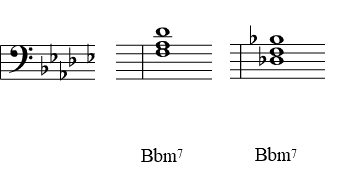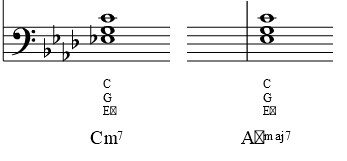Page 1 of 2
All the things you are, Intermadiate
Posted: Sun Jan 27, 2019 6:50 am
by pavel

- Fm7.png (3.79 KiB) Viewed 9472 times
measure 10 and 19 shows the same description even notes are different, why?
Re: All the things you are, Intermadiate
Posted: Sun Jan 27, 2019 11:09 am
by andrewwegierski
Fm7 = F, Ab, C, Eb.
In measure 10, this is a common jazz voicing. The 5th is the least important chord member because it is naturally produced as an overtone from the root, F. So here you have 1, 3, 7.
In measure 19, this is known as a rootless voicing. You see C, Eb and Ab, or, 5, 7, 3. It's probably like this for ease of hand position. It's the same notes without the F, and the bass is playing the F, so it's not always necessary.
Re: All the things you are, Intermadiate
Posted: Sun Jan 27, 2019 12:39 pm
by sw1tch73ch
Something to remember is that the 7th chord, in its most basic usage, is a four note chord. In the two measures, you have only three notes of the Fm7 actually voiced. So the fourth member of the chord is implied or covered by something in the accompaniment. Fm7 is an F minor with the 7th added > (F, Ab, C) + Eb. In the two measures you have three of these four actually played, but a different member of the Fm7 is left out - the C in measure 10 and the F in measure 19.
Also, measure 10 is in Root position and measure 19 is in 2nd Inversion. They look different, but have the same soul, if you will.
Re: All the things you are, Intermadiate
Posted: Sun Jan 27, 2019 12:48 pm
by pavel
Wau, thank you, I have a lot to learn though


Re: All the things you are, Intermadiate
Posted: Mon Jan 28, 2019 5:40 pm
by andrewwegierski
Yes John, in the second example, the bass is covering the F.
However in the first example, it's possible that no other instruments are playing C. It's the least important chord member because it's a naturally produced overtone. Also, it doesn't provide any harmonic information that differs this harmony from Fmajor7 or F7 - they all have a C.
Re: All the things you are, Intermadiate
Posted: Tue Jan 29, 2019 11:37 am
by sw1tch73ch
andrewwegierski wrote: ↑Mon Jan 28, 2019 5:40 pm
Yes John, in the second example, the bass is covering the F.
However in the first example, it's possible that no other instruments are playing C. It's the least important chord member because it's a naturally produced overtone. Also, it doesn't provide any harmonic information that differs this harmony from Fmajor7 or F7 - they all have a C.
That's what I meant by implied. It's like your ears hear it whether it's there or not.
Re: All the things you are, Intermadiate
Posted: Sat Feb 02, 2019 3:15 am
by pavel
as a beginner I am still confused, honestly I would be less confused if I dont have those letters bellow. For example why note E has b symbol twice?

- Fm7 again.png (9.04 KiB) Viewed 9370 times
Re: All the things you are, Intermadiate
Posted: Sat Feb 02, 2019 3:19 am
by pavel
another example

- Bbm7.png (3.63 KiB) Viewed 9370 times
apart from that, again doubling b symbol
Re: All the things you are, Intermadiate
Posted: Mon Feb 04, 2019 11:54 pm
by pavel
Cm7 is perfect example why I am strugling

- Cm7.png (4.12 KiB) Viewed 9299 times
btw another b symbol twice but only for Cm7 (next to clef) not for Abmaj7 where it is more useful (if any)
Re: All the things you are, Intermadiate
Posted: Tue Feb 05, 2019 9:11 am
by pavel
my brain hurts

hope you know that sketch from Monty Python, answer to my question, because
Fm7 = F Ab C Eb
but also
Fm7 = Ab C Eb F
Fm7 = C Eb F Ab
Fm7 = Eb F Ab C
and sometimes there is least important chord member, as a result we can have
Fm7 = F Ab Eb
or member covered by something in the accompaniment, as a result we can have
Fm7 = C Eb Ab
are my assumptions right?

